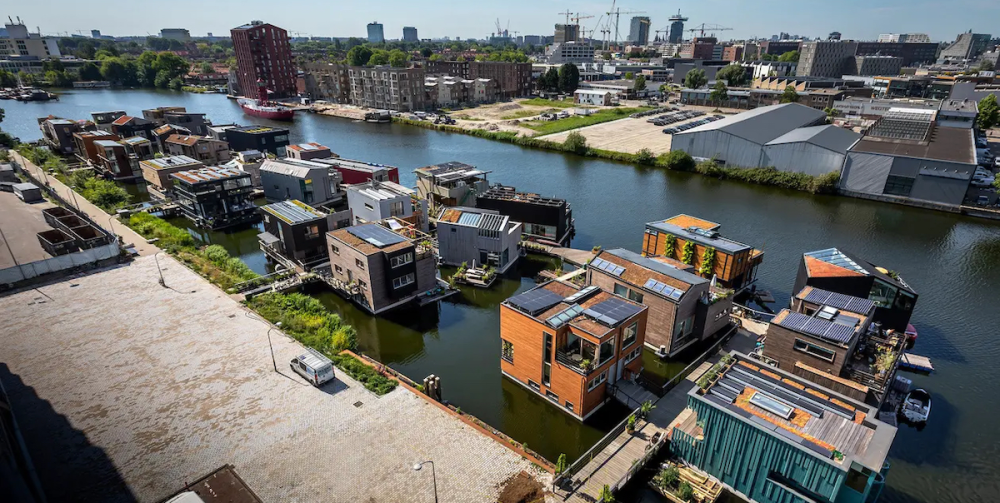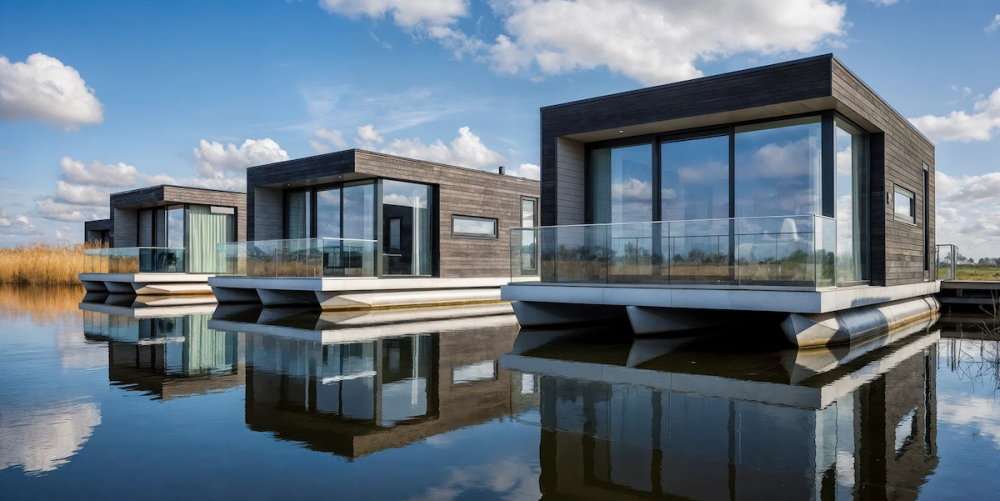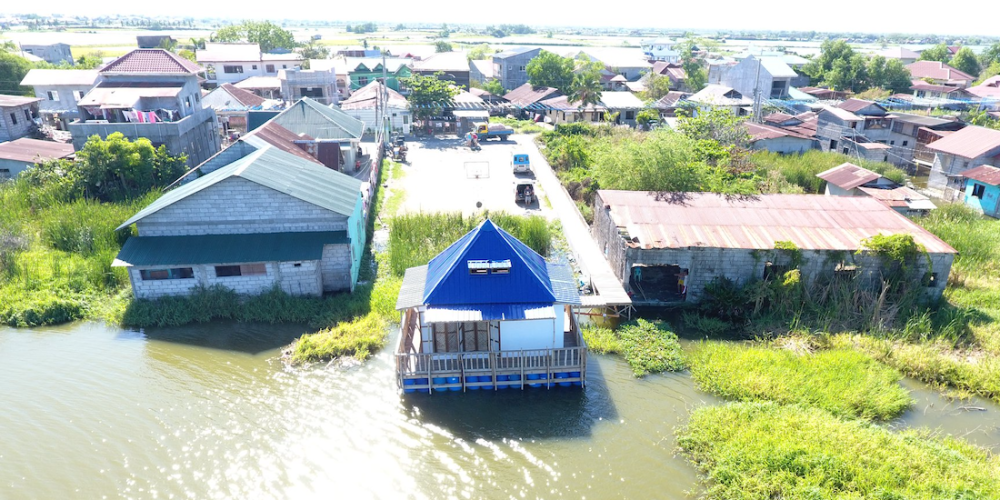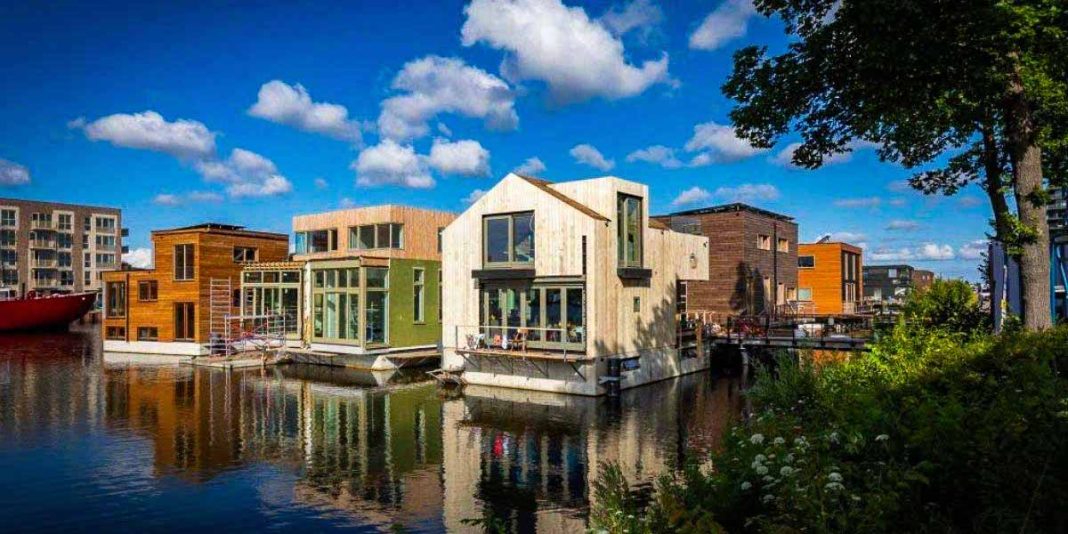As sea levels rise and storms intensify, the Netherlands pioneers innovative aquatic architecture to address flooding and housing crises globally.

New York, N.Y. – When torrential rains battered Amsterdam in October 2022, residents of Schoonschip—a pioneering floating community—barely flinched. They secured bicycles and outdoor furniture, checked on neighbors to ensure adequate supplies, and settled in as their homes rose and fell along steel foundational pillars, moving with the water rather than fighting against it.
Rising Waters Meet Innovative Architecture
The Netherlands has long battled water, with approximately 26% of the country lying below sea level. Traditional solutions—dikes, levees, and pumping stations—have protected Dutch cities for centuries, but climate change is intensifying the challenge. As sea levels rise and storms grow more severe, the Dutch are increasingly looking to live with water rather than simply hold it back.
Floating homes represent a paradigm shift in this approach. Unlike traditional houseboats that can be easily unmoored and relocated, these structures are permanently anchored to the shoreline, typically resting on steel poles that allow vertical movement with changing water levels. They connect to local sewer systems and power grids just like land-based houses. The key innovation lies in their concrete hull foundation, which acts as a counterweight to maintain stability while allowing the structure to rise and fall with water levels.
“These homes are structurally similar to conventional houses, but instead of a basement, they have a buoyant concrete hull,” explains Koen Olthuis, founder of Waterstudio, a Dutch architecture firm specializing in aquatic construction. “They’re built with standard materials—timber, steel, glass—but designed to float.”

From Concept to Community
The Netherlands’ floating communities, which have emerged primarily over the past decade, began as experimental projects but have evolved into fully functional neighborhoods. Schoonschip, home to approximately 100 residents across 46 households, serves as a living laboratory for this technology. The community, whose name translates to “clean ship,” was designed with sustainability at its core, incorporating solar panels, heat pumps, and a shared energy grid.
Residents report that living on water requires adjustments. Storm preparation becomes routine, and the gentle motion of homes can take time to get used to. However, the benefits extend beyond flood protection. Many inhabitants cite a unique sense of community, fostered by their shared commitment to innovative living and environmental stewardship.
The success of Schoonschip and similar Dutch projects has attracted international attention. As demand grows domestically—driven by both flooding concerns and a severe housing shortage in the Netherlands—officials are working to modernize zoning laws and building codes to facilitate floating home construction.
Exporting Expertise to Vulnerable Nations
Dutch engineers are now spearheading ambitious floating development projects worldwide, particularly in regions facing existential threats from rising seas. The Maldives Floating City, designed by Olthuis and his team, represents one of the most ambitious undertakings. This planned ocean-based development aims to provide 20,000 residents with homes, restaurants, shops, and schools across a lagoon near the capital, Malé.
For the Maldives, a nation of low-lying islands in the Indian Ocean, the stakes couldn’t be higher. With 80% of the country less than 3.3 feet (1 meter) above sea level, projections suggest much of the archipelago could become uninhabitable by 2100 without dramatic intervention. Floating cities offer a potential lifeline, allowing the nation to expand living space while adapting to rising waters.
“We’re not just building homes; we’re creating resilient infrastructure for nations whose very existence is threatened by climate change,” says Olthuis. “The technology we’ve proven in the Netherlands can be scaled up and adapted to different environments worldwide.”

Global Interest and Implementation
Beyond the Maldives, Dutch floating home expertise is being applied in French Polynesia, where rising seas threaten island communities, and in European nations including Britain, France, and Norway. Even more ambitious are proposals for floating islands in the Baltic Sea capable of supporting small cities.
These projects face significant challenges. Construction costs for floating homes typically exceed those of traditional houses by 20% to 25%, though proponents argue this premium is justified by enhanced flood protection and longevity. Regulatory frameworks in many countries lack provisions for aquatic construction, requiring extensive legal groundwork before projects can proceed.
Engineering challenges also persist. Floating structures must withstand not only storms and waves but also ice formation in colder climates. They require specialized infrastructure for utilities, waste management, and access. Scaling from individual homes to entire communities—and eventually floating cities—demands solutions to complex logistical and technical problems.

Addressing Housing and Climate Simultaneously
In the Netherlands, floating homes address two critical issues simultaneously: climate adaptation and housing scarcity. The country faces a shortage of approximately 300,000 homes, with demand particularly acute in urban areas like Amsterdam and Rotterdam. Traditional land-based development is constrained by the country’s high population density and limited available space.
“Floating construction allows us to utilize water surfaces that were previously considered unbuildable,” notes a Dutch urban planner. “This effectively expands our available land area without requiring land reclamation, which is expensive and environmentally disruptive.”
The environmental benefits extend beyond flood resilience. Many floating communities incorporate sustainable design elements, including solar energy, rainwater collection, and natural water filtration systems. Some developments create artificial reefs beneath floating structures, enhancing marine biodiversity while stabilizing foundations.
The Future of Aquatic Living
As climate projections become increasingly alarming—with the United Nations estimating that sea level rise could displace up to 410 million people by 2100—the Dutch model of floating homes offers a practical response. While not suitable for every location or community, this approach provides coastal regions with an alternative to retreat or expensive coastal defenses.
The technology continues to evolve. Newer designs incorporate modular construction for easier expansion, advanced materials for improved durability, and smart systems for monitoring structural integrity and environmental conditions. Some architects envision entire floating districts with parks, offices, and public spaces, not just residential buildings.
However, experts caution against viewing floating homes as a panacea. “This is one tool in our adaptation toolkit, not the only solution,” emphasizes a climate resilience researcher. “We still need to reduce emissions, protect existing coastlines, and help communities relocate when necessary. But for many places, floating construction can be part of a comprehensive strategy.”
A Dutch Export With Global Implications
The Netherlands’ embrace of floating homes reflects the nation’s historical relationship with water—one characterized by adaptation and innovation rather than defeat. As climate change accelerates and coastal flooding intensifies worldwide, this Dutch expertise may prove invaluable to vulnerable nations.
From individual floating houses in Amsterdam to proposed floating cities in the Maldives, these projects represent more than architectural novelty. They embody a fundamental rethinking of humanity’s relationship with water, moving from resistance to coexistence. As Olthuis puts it: “We’re not fighting the water anymore. We’re learning to live with it, on it, and maybe even because of it.”
For coastal communities worldwide facing an uncertain future, the Dutch approach to floating homes offers not just a blueprint for construction, but a model of resilience in the face of environmental change.
Dutch Floating Homes Offer Blueprint for Climate Resilience (Oct. 27, 2025)
Summary
In the face of rising seas and intensifying storms, the Netherlands has emerged as a global leader in floating home construction. These innovative communities, built atop water rather than land, offer a potential solution to coastal flooding while addressing critical housing shortages. Dutch engineers are now exporting this expertise to vulnerable nations worldwide, from the Maldives to French Polynesia, as climate change threatens coastal populations.
#FloatingHomes #ClimateAdaptation #SustainableArchitecture #RisingSeaLevels #Netherlands
#ClimateResilience #GreenBuilding #UrbanPlanning #CoastalFlooding #InnovativeHousing
TAGS: climate change, floating homes, Netherlands, sea level rise, sustainable architecture,
flood resilience, Maldives, urban planning, housing shortage, aquatic construction, Dutch engineering,
climate adaptation, coastal communities, environmental sustainability, innovative infrastructure
Social Media Posts
Facebook: The Netherlands is pioneering a revolutionary approach to rising sea levels: floating homes. These innovative structures, anchored to shorelines but able to rise and fall with water levels, offer a potential solution to coastal flooding while addressing critical housing shortages. Dutch engineers are now exporting this expertise to vulnerable nations worldwide, from the Maldives to French Polynesia, as climate change threatens coastal populations. Could floating communities be the future of coastal living? Read more about how the Dutch are learning to live with water rather than fight against it.
Instagram: Rising seas. Intensifying storms. Housing shortages. The Netherlands has an innovative answer: floating homes. These aren’t traditional houseboats—they’re permanent residences anchored to steel pillars, rising and falling with water levels while staying connected to power grids and sewer systems. Dutch floating communities like Schoonschip in Amsterdam have proven the concept works, and now engineers are scaling up with ambitious projects worldwide, including a floating city in the Maldives designed for 20,000 residents. As climate change accelerates, could aquatic architecture become the norm for coastal communities? The Dutch are showing us how to adapt, not retreat.
LinkedIn: Climate adaptation meets innovative engineering: The Netherlands is leading the global shift toward floating home construction. As sea levels rise and coastal flooding intensifies, Dutch engineers are demonstrating that living with water—rather than fighting against it—offers a viable path forward. Floating communities like Schoonschip in Amsterdam have proven the technology’s reliability, withstanding severe storms while addressing critical housing shortages. Now, Dutch firms are exporting this expertise internationally, with projects underway in the Maldives, French Polynesia, and across Europe. These developments represent more than architectural innovation; they embody a fundamental rethinking of coastal infrastructure for the climate change era. For professionals in urban planning, sustainable development, and climate resilience, the Dutch floating home model offers valuable insights into adaptive construction and long-term climate strategy.
X / Twitter: The Netherlands is pioneering floating homes as a solution to rising seas and housing shortages. These aren’t houseboats—they’re permanent structures anchored to shorelines, rising with water levels. Dutch engineers are now exporting this climate adaptation tech to vulnerable nations worldwide, including a planned floating city in the Maldives for 20,000 residents.
BlueSky: Dutch innovation meets climate reality: Floating homes are emerging as a practical solution to coastal flooding and housing crises. Amsterdam’s Schoonschip community has proven the concept—homes anchored to steel pillars that rise and fall with water levels, connected to standard utilities. Now Dutch engineers are scaling up globally, with projects from the Maldives to French Polynesia. As sea levels rise and threaten 410 million people by 2100, these aquatic communities offer more than shelter—they represent a new way of living with water instead of against it.




